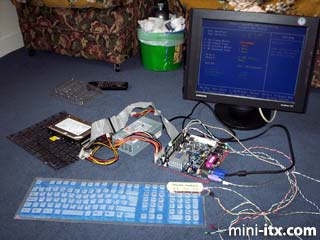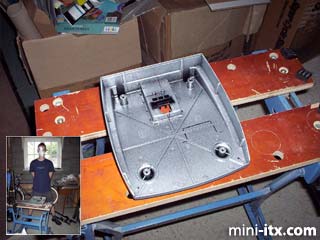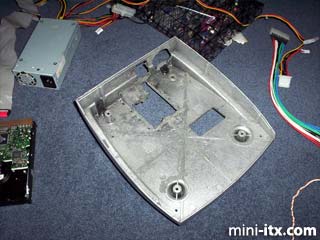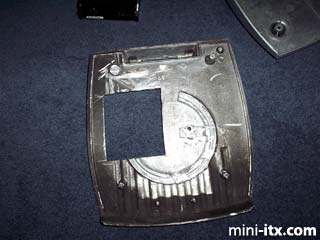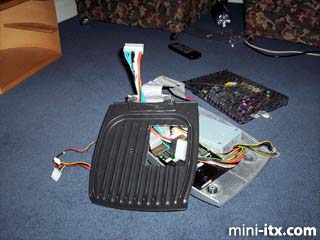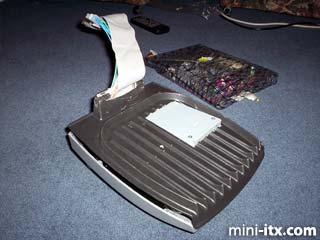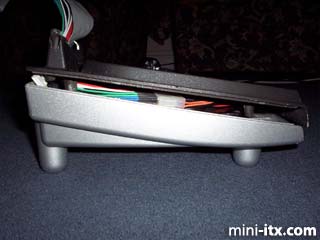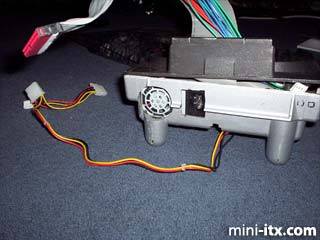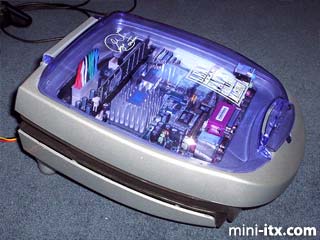Posted on January 17, 2005
So it all fit, the components worked, and I had a plan of attack. There was only one thing to do. Get out the workbench, the dremel, put on the protective gear, and start hacking. The plastic fumes and metal shards are thoroughly nasty, so remember kids, safety first!
The result of this vicious attack on a defenceless piece of metal and plastic was some nice space and ventilation holes, and a severe lack of grill elements. The elements were actually a real pain to remove, as they were encased in a half-centimetre of metal, which made life quite hard.
Later, it turned out the ATX cabling would end up requiring another gouge out of the lower grill plate. Since the lower plate is pretty much hidden from view, this wasn't such a big deal.
It was only after putting the base together for the first time that I realised the lower plate needed more work. The big fat ATX plugs wouldn't fit.
The base almost closed, but no amount of squishing down would rectify the problem, and I would eventually end up further mutilating the lower grill plate to fit everything in.
The lower grill plate got sliced up to allow some cables to poke out. Not the cleanest solution, but it works.
One small hole later, the base section closed beautifully. Next up, the element and some extraneous metal was removed from the top grill plate. I cut a few notches out of the top plastic portion to allow a power-light cable to fit underneath, illuminating the grill's old power-light space. That was pretty much it for the hardware side.
The OS, Gentoo Linux, took about a week to get fully up and running, as the 600Mhz Eden cpu doesn't exactly scream through large software compiles. The iGrill is pretty lightweight. Most of its life is spent as a music/movie server.
The full component list is:
- George Foreman "Junior" Grill
- VIA Epia CL6000 Mini-ITX motherboard
- 80GB 7200rpm 8MB cache Seagate Barracuda hard drive
- Shuttle SilentX 250W Power Supply
- 512MB PC2100 RAM
All in all, I had a great time doing this project, and I'm really pleased with the results. I'm pretty sure I've got a one-of-a-kind machine now, and so far, it's proving pretty stable, and a nice quiet performer.
 |
 |
 |
Quick Links
Mailing Lists:
Mini-ITX Store
Projects:
Show Random
Accordion-ITX
Aircraft Carrier
Ambulator 1
AMD Case
Ammo Box
Ammo Tux
AmmoLAN
amPC
Animal SNES
Atari 800 ITX
Attache Server
Aunt Hagar's Mini-ITX
Bantam PC
BBC ITX B
Bender PC
Biscuit Tin PC
Blue Plate
BlueBox
BMW PC
Borg Appliance
Briefcase PC
Bubbacomp
C1541 Disk Drive
C64 @ 933MHz
CardboardCube
CAUV 2008
CBM ITX-64
Coelacanth-PC
Cool Cube
Deco Box
Devilcat
DOS Head Unit
Dreamcast PC
E.T.PC
Eden VAX
EdenStation IPX
Encyclomedia
Falcon-ITX
Florian
Frame
FS-RouterSwitch
G4 Cube PC
GasCan PC
Gingerbread
Gramaphone-ITX-HD
GTA-PC
Guitar PC
Guitar Workstation
Gumball PC
Hirschmann
HTPC
HTPC2
Humidor 64
Humidor CL
Humidor II
Humidor M
Humidor PC
Humidor V
I.C.E. Unit
i64XBOX
i-EPIA
iGrill
ITX Helmet
ITX TV
ITX-Laptop
Jeannie
Jukebox ITX
KiSA 444
K'nex ITX
Leela PC
Lego 0933 PC
Legobox
Log Cabin PC
Lunchbox PC
Mac-ITX
Manga Doll
Mantle Radio
Mediabox
Mega-ITX
Micro TV
Mini Falcon
Mini Mesh Box
Mini-Cluster
Mobile-BlackBox
Moo Cow Moo
Mr OMNI
NAS4Free
NESPC
OpenELEC
Osh Kosh
Pet ITX
Pictureframe PC
Playstation 2 PC
Playstation PC
Project NFF
PSU PC
Quiet Cubid
R2D2PC
Racing The Light
RadioSphere
Restomod TV
Robotica 2003
Rundfunker
SaturnPC
S-CUBE
SEGA-ITX
SpaceCase
SpacePanel
Spartan Bluebird
Spider Case
Supra-Server
Teddybear
Telefunken 2003
TERA-ITX
The Clock
ToAsTOr
Tortoise Beetle
Tux Server
Underwood No.5
Waffle Iron PC
Windows XP Box
Wraith SE/30
XBMC-ION

